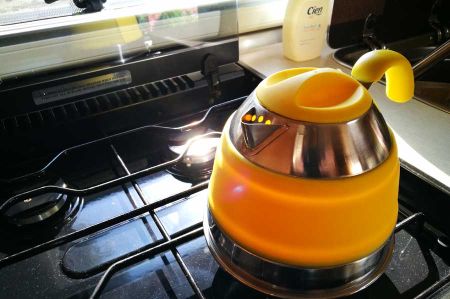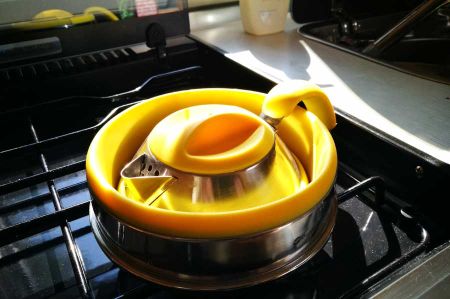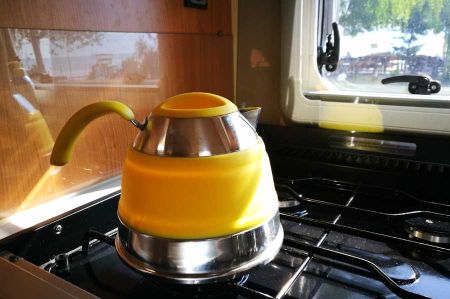Water Kettle - relic from the past - return at camping?
- Written by Portal Editor
We admit it - several times we had overloaded the campsite network with our electric water heater, which then temporarily shut down the power supply followed.
To apologize to the neighbors first then the recourse to the pot for water heating by gas was the solution. Due to our activities (exploration and installation of hiking and biking trails), often away from the normal tours and the associated overnight stay away from the campsites electrical power was lost anyway, so we were looking for alternatives for the morning preparation of the coffee. Every camper knows that weight and pack size should always play a role in all purchases, if you do not want to overburden the payload and space in the vehicle. A conversation with our sponsor Frankana during the CMT fair was supposed to solve the "problem": the kettle to fold.
Water kettle made of stainless steel, formerly from copper
 According to our research, the kettle has been used in households since the 17th century when it comes to warming coffee or tea water. Mostly holding a content of about two liters of water, the modern kettle is made of stainless steel, formerly also made of aluminum or copper. For rapid heating of the water, the kettles, unlike the cooking pot often have very thinly prepared floors to ensure a direct thermal contact with the hob, gas or electric stove.
According to our research, the kettle has been used in households since the 17th century when it comes to warming coffee or tea water. Mostly holding a content of about two liters of water, the modern kettle is made of stainless steel, formerly also made of aluminum or copper. For rapid heating of the water, the kettles, unlike the cooking pot often have very thinly prepared floors to ensure a direct thermal contact with the hob, gas or electric stove.
Kettles also feature a steam whistle, which signals the outflowing, hot steam when the water in the kettle has reached its boiling point. In such kettles, which are filled directly via the spout, the water vapor can not escape through other scratches, such as those caused by a lid. This construction, which is comparable to a pressure cooker, allows very fast and efficient heating. Boilers that are offered with large filling openings, therefore, have a well-closing lid to ensure the necessary pressure build-up.
Modern kettle made from steel and silicon
 So much about the historical background - and perhaps also for the renaissance of the kettle, because what we were offered had not much to do with the kettle and the associated steam whistle, which by the way, was completely missing. A small package was then the first surprise: a foldable kettle came to light, which consisted of a stainless steel bottom, a ring of yellow silicone and the top again made of stainless steel ring and a silicone lid fit into it. Of course we were better acquainted with cooking utensils made of silicone for a long time, but not as a foldable kettle. So the pack size is correspondingly small, the weight low - in short, just in practice the test was missing.
So much about the historical background - and perhaps also for the renaissance of the kettle, because what we were offered had not much to do with the kettle and the associated steam whistle, which by the way, was completely missing. A small package was then the first surprise: a foldable kettle came to light, which consisted of a stainless steel bottom, a ring of yellow silicone and the top again made of stainless steel ring and a silicone lid fit into it. Of course we were better acquainted with cooking utensils made of silicone for a long time, but not as a foldable kettle. So the pack size is correspondingly small, the weight low - in short, just in practice the test was missing.
Easily unfolded the application of the kettle then showed, which incidentally absorbs 1.5 liters of water, enough to fill the thermos with morning coffee (perhaps for some old-fashioned or backward - the self-filtered coffee tastes the best). Meanwhile, tested over a longer period of time, no disadvantages compared to a conventional kettle to be noticed, on the contrary neither the taste of water is changed nor shows the silicone signs of fatigue. In short, a modern product with low weight and small pack size.
Please read as well:
And another innovative novelty - a tiny compact kitchen
GentleTent for marketing shots at Lake Ohrid
